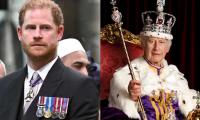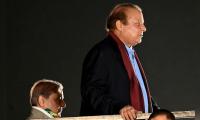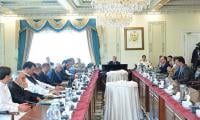Bloody, violent and effective – the latest dharna has achieved what the last three dharnas were unable to accomplish. All these achievements would not be possible had dharna technology not been invented, tested and tried on three earlier occasions, twice by Barelvi scholars.
The newly invented Pakistani dharna technology is terrorism without gunpowder. Like karate, it uses the energy and momentum of democracy against it. Archimedes, the Greek mathematician claimed explaining the power of lever: “Give me a place to stand on, and I will move the Earth.” The power of Pakistan’s dharna technology is no different; let 1800 people occupy a strategic place in the capital and they can freeze a state of 200 million people for twenty.
Like modern terrorists who like to hold a place for hours or days rather than disappearing after the attack, the dharna aims at making the media hostage for a prolonged period. It feeds on an ineffective state, afraid of public opinion and over-accountable courts. The nature of the crowd, the nature of the state and the overall political situation combine to create this unique situation. Let’s see how this technology works.
Democracy allows people to protest peacefully. Much of the public protests all over the world are aimed at demanding better services or convincing the government to change its policies. In rare cases, people take to streets to force a government to resign.
In democracy, such protests only have a moral value. Whatever the size or nature of these protests, they cannot take away the constitutional right of a government to make policies or govern a country. On February 15, 2003, one million protesters took to the streets of London to oppose the looming war against Iraq. Large peaceful protests were also held all over the country and around the world. Up to 60,000 protesters gathered in Glasgow and up to 90,000 in Dublin, while Italy had the biggest protest, with an estimated two million peace campaigners on the streets of Rome. However, the elected governments in Europe refused to listen to the protesters and sent their armies to support the US in the Iraq war.
Peaceful protests can be very hard to handle for weak-kneed monarchies and dictatorships. In the late 20th century, a number of movements have been able to demonstrate that longstanding dictatorships can be overturned without bloodshed.
Pakistan is no stranger to peaceful revolutions. Perhaps, it is the only country in the world that threw out three military dictators in the post-world war era. There have also been uprisings that turned out to be counter-revolutions and resulted in dictatorships. In 1977, the PNA movement popularly known as Tehreek-e-Nizam-e-Mustafa succeeded in overthrowing the elected prime minister only to bring in the dictatorship of Ziaul Haq.
Dharna technology is different. It benefits from the freedom of assembly allowed in a democracy and feeds on the weakness of the state. The main aim of the dharna is to make the media hostage by occupying a strategic space over a prolonged period. These kind of dharnas would not be possible in a world before the 24/7 electronic media, or in a small city.
Like terrorism, dharnas succeed in exposing the weakness of the state and its failure to protect the public property and its citizens. By exposing this weakness and creating an environment of uncertainty, organisers of dharnas hope to force a regime change or blackmail a government into accepting their demands.
We do not know who invented Pakistan’s dharna technology but it was first employed by Tahirul Qadri, who arrived in Islamabad on January 14, 2013 with his long march of some 25000 followers and occupied D-Chowk. This dharna ended three days later without realising its stated objective of overthrowing the government.
The dharna technology was used to its full force when Imran Khan arrived with his Azadi march and and Tahirul Qadri with his Inqilab March in December 2014, and staged a joint dharna at Islamabad’s D-Chowk. This dharna also ended after one hundred and twenty six days without delivering us azadi (freedom) or inqilab (revolution).
Maulana Khadim Hussain Rizvi, the star of the recent dharna, tried his hand at dharna technology in March last year after holding the chehlum of Mumtaz Qadri who was hanged on February 29. An effective siege of the dharna convinced Maulana and his companions to leave.
While retreating, the Maulana left an indelible mark on minds of the users of social media. His use of Punjabi for innovative abuses in his religious sermons amused some people and made others cringe. Many of these educated people did not know that our ulema have been using such language from time immemorial, because apart from religious guidance they also provide us much needed entertainment. The same clips established Rizvi as a new defiant leader of Barelvi politics in Pakistan. Many of his followers gave him the title of Amirul Mujahidin (the leader of Mujahids).
His recent dharna proved more effective than any earlier dharnas because he was allowed to occupy the Faizabad Interchange, the most important point in the road system of the twin cities. This created enormous hardship for millions of residents of the two cities.
The PML-N government was able to use its executive power effectively during the PTI’s planned siege in October last year and Khadim Hussain’s first dharna but proved ineffective during the PTI’s prolonged dharna and the recent dharna of the Tehreek-e-Labaik Party. The difference has been made by the overall political situation, civil-military relations and the pressure the executive felt from institutions of accountability.
The PML-N has attracted the bulk of the Barelvi vote bank in Punjab throughout its existence. The by-election in NA-120 has created a threat that this segment of its voters can leave it for good. Similarly, PML-N has been afraid of the situation getting out of control and turning into a Model Town-like crisis. Maulana Khadim Hussain was heading a small but hysterical crowd that had made its violent intentions quite clear. Some of the PML-N’s fears may prove true after the decisive action against the dharna.
The Tehreek-e-Labaik appears to have mobilised a segment of society that was left unattended by other parties. Unfortunately, rather than rallying around a socio-economic agenda, this segment is getting mobilised around an extremist sectarian agenda.
On the political level, our ulema have always been a headache to the moral community of South Asian Muslims, pushing us to unchartered territories and bringing disaster upon disaster. From Maulana Azad’s Tehreek Hijrat to Maulana Muanwar Hassan’s Qital-fi-Sabeel-lillah within the country, it is hard to find anything good emerging out of their engagement in politics. With the Tehreek-e-Labaik a new beauty is born.
It appears that dharna technology is here to stay, and it has become more difficult for the government to take action against a religious group making the capital hostage. Who should we congratulate for this brilliant success?
The writer is an anthropologist and development professional.
Email: zaighamkhan@yahoo.com
Twitter: @zaighamkhan
People stand in line up as election officials check their ballot papers during voting general election at a polling...
Women show their voter identity cards as they stand in a queue before casting their votes in Agartala. — PTIThe 18th...
Former prime minister Imran Khan. — Instagram/ imrankhan.ptiAn old saying has it that “when you dance with the...
Kashmiris in Indian illegally occupied Kashmir protesting against the Indian occupation as the forces of India looked...
A representational image showing residents walking at a wholesale market in Karachi. — AFP/FileOnce again there is...
A representational image showing late Pakistani human rights activist and Supreme Court lawyer Asma Jahangir. —...







